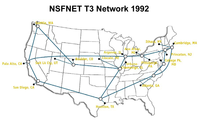
Photo from wikipedia
The new ways to consume and deliver media content in a wireless environment have led to a significant increase in the demand for spectrum resources. In addition, the arrival of… Click to show full abstract
The new ways to consume and deliver media content in a wireless environment have led to a significant increase in the demand for spectrum resources. In addition, the arrival of next-generation wireless communication technologies has encouraged the creating of new verticals targeting novel applications, such as industry IoT, e-health, distance learning, smart city, smart-metering. All these new use cases are centred on an IP-based infrastructure. A promising alternative to satisfy the demand for resources is to incorporate a new delivery mechanism that can alleviate the congestion of classical cell-based point-to-point broadband wireless infrastructures. The best-positioned candidate is the next-generation Digital Terrestrial Television system, which offers a very spectrum efficient one-to-many PHY, and for the first time, native IP support. In ATSC 3.0, the whole system was designed with an IP-centric view, whereas DVB has created standards to deliver services to generic IP devices (DVB-I). Nevertheless, there is still a last missing piece to bring the broadcast infrastructure to the IP-connected world: a Broadcast Core Network (BCN). In this paper, the basics of a BCN are presented with new use cases that are attractive to Broadcast Network Operator (BNO). A possible roadmap towards implementation is described, and a service-based architecture for a BCN is presented and discussed.
Journal Title: IEEE Transactions on Broadcasting
Year Published: 2021
Link to full text (if available)
Share on Social Media: Sign Up to like & get
recommendations!